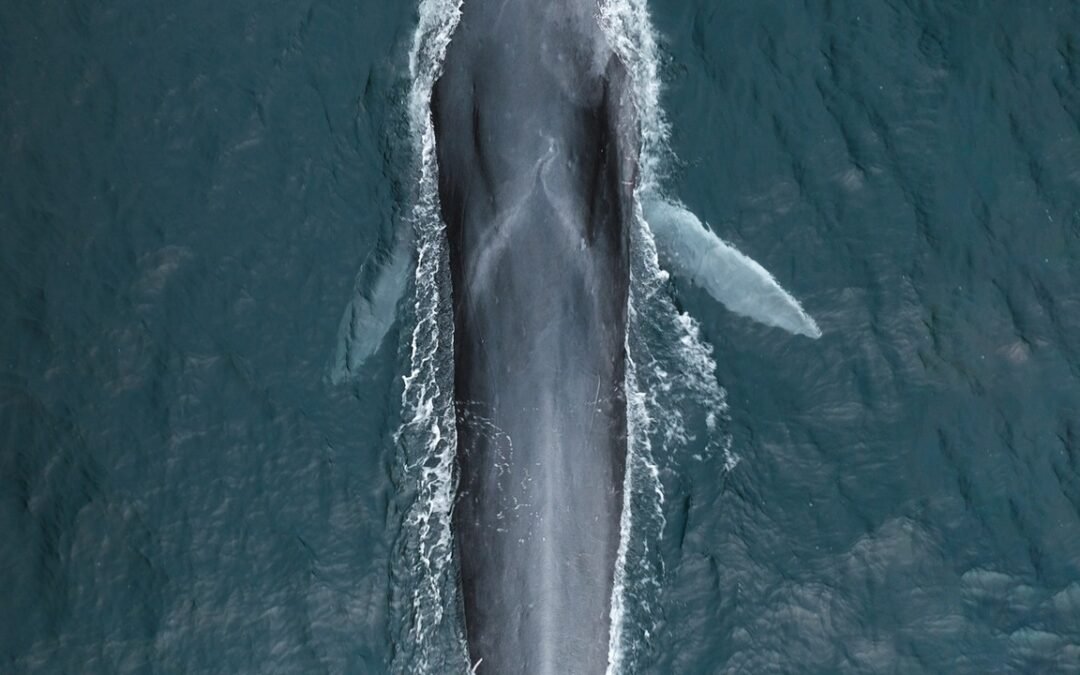The Fin Whale, a large baleen cetacean measuring up to 25 meters in length, belongs to the family Balaenopteridae. Characterized by a hydrodynamically streamlined body and swift swimming capabilities, it is second in size only to the Blue Whale. Most members of this family look similar, making it challenging to distinguish them at sea. The Fin Whale’s distinctive feature is the asymmetrical pigmentation on its lower jaw—dark on the left and light on the right. This pattern extends to part of the baleen plates. In the northern and southern hemispheres, Fin Whales are considered separate subspecies: B. p. physalus in the north and B. p. quoyi in the south. Genetic evidence supports the distinction between North Atlantic and North Pacific Fin Whales as different subspecies, yet new names are pending. In Canada, COSEWIC regards these as separate designatable units. Historically, Fin Whales were heavily targeted during 20th-century whaling, depleting populations in the Canadian Atlantic and Pacific. Nowadays, they are a highlight for whale watching in nearshore Canadian Atlantic waters.
Fin Whales are found almost globally in all major oceans, with highest densities in cool temperate and subpolar waters, and are mostly absent near the equator. They inhabit both oceanic and coastal areas, migrating to high latitudes in summer for feeding and to lower latitudes in winter for breeding. However, they can be found in Canadian waters year-round.
In Canadian waters, Fin Whale habitats are marked by oceanographic features that boost prey production and concentration. In the Atlantic, their presence is often linked to productive oceanic fronts with high densities of euphausiid crustaceans. They inhabit various bathymetric features, from continental shelves to deep canyons in the Gulf of St. Lawrence and topographically varied areas in the Bay of Fundy. In the Pacific, they aggregate along the continental slope, especially where canyons and troughs concentrate euphausiids. They also frequent deep channels between islands along British Columbia’s northern coast. Their presence off both coasts during winter suggests courtship, mating, and possibly calving occur in Canadian waters.
Fin Whales reach sexual maturity at 6 to 8 years and physical maturity at around 25 years, with a lifespan up to 100 years. Their generation time is approximately 25 years. Conception and calving, following an 11 to 12-month gestation, primarily occur in winter. Data from British Columbia indicate that 75% of births occur between mid-October and mid-February, peaking in December. Newborns are about 6 meters long and are weaned at 6 to 7 months. The average interval between births is about 2.24 years, with adult female pregnancy rates estimated at 38 to 50%.
Despite the end of large-scale whaling over 50 years ago, around 20 Fin Whales are hunted annually for subsistence in Greenland, and Iceland hunted 146 in 2018. Increasing ocean noise from oil and gas exploration, shipping, wind farms, and military exercises poses threats, causing displacement, disturbance, injury, and communication signal masking. Vessel strikes are a significant mortality source, particularly in busy shipping areas on both coasts. Fatalities from vessel strikes are likely underreported, as many struck whales sink undetected. Entanglement in fishing gear is another mortality cause, particularly in the Atlantic. Other threats include habitat suitability shifts and toxic pollutants.
The Species at Risk Act (SARA) provides measures for protecting certain listed species, including their critical habitats. Conservation responsibility is shared across Canada, with all Canadians playing a role in wildlife protection. For more information on SARA and provincial or territorial protection measures, consult relevant government websites.
See original post here.








Be Awesome!
Share Or Like This Post And Get +10 Karma Points :-)